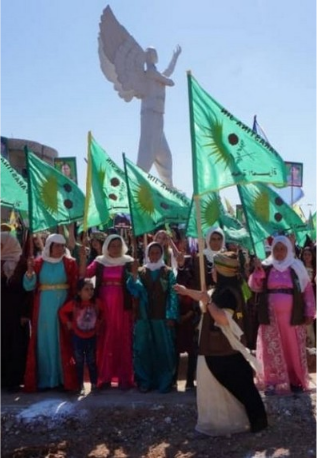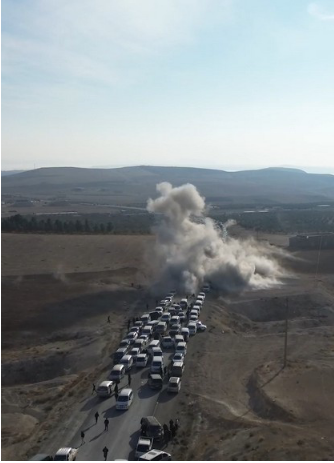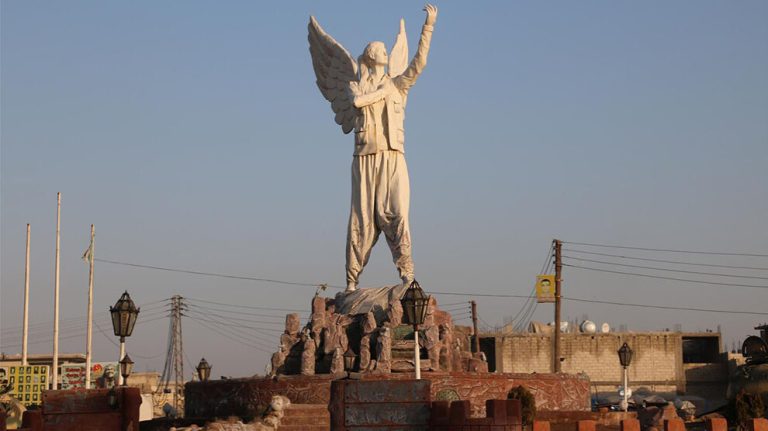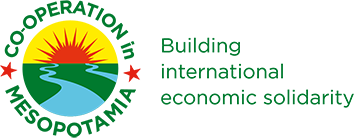Kobane is one of the cities of Rojava, which has been located in the north on the border withTurkey/North Kurdistan since the partition of Kurdistan by the Treaty of Lausanne in 1923. The city lies about 30 kilometres east of the Euphrates. It is mainly inhabited by Kurds. There was an Armenian community until the 1970s. Arab families have mainly settled in some of the neighbouring villages. Traditionally, the people of the region have lived from agriculture and animal husbandry, and in the town from handicrafts. The region, once rich in springs and fertile soil, has been increasingly drained in recent decades by Turkish dam projects. Despite this, the city’s population grew from around 55,000 in 2007 to around 100,000 in 2014. Under the Baath regime, Kobane and the surrounding villages were an administrative district of Aleppo. In the course of the Rojava Revolution in 2014, the population established the self-administered canton of Kobane, which is still part of the Democratic Autonomous Administration in Northern and Eastern Syria.

The significance of Kobane
In the wake of the people’s uprisings against despotic regimes in North Africa and the Middle East, the protests against the Assad regime in Syria also began in spring 2011. The Kurds in Rojava (Western Kurdistan), who had been oppressed for decades by the nationalist policiesof the Ba’ath dictatorship, demanded both a fundamental democratisation of Syria and recognition of their political and cultural self-determination. On 19 July 2012, the people of Kobane urged the Syrian military and the state apparatus to withdraw from the city. This was the beginning of the Rojava Revolution. Municipal and women’s councils set up by elected commune representatives took over the organisation of society’s affairs. This laid the foundations for the Democratic Autonomous Administration, which is based on the principles of grassroots democracy, ecology, women’s liberation and cultural and language diversity. Shortly afterwards, the Kurdish people in the regions of Efrin and Cizire followed Kobane’s example. In January 2014, the canton of Kobane was proclaimed as one of three self-administered cantons of the Democratic Autonomy based on the Social Contract of Rojava.
A review of the attacks on Kobane

The attacks on the Democratic Autonomous Administration in Kobane, which continue to this day, began with the major offensive of the ‘Islamic State’ (ISIS) in September 2014. Then as now, Turkey played a leading role. Thousands of ISIS mercenaries, militarily trained, equipped and led by Turkey, crossed the border into Syrian territory to attack Kobane. In October 2014, ISIS, armed with heavy artillery, depopulated and occupied a large part of the city of Kobane and 300 surrounding villages. More than 300,000 people were displaced. Turkish Prime Minister Erdoğan declared at the time: ‘Kobane has fallen’. With the genocide and feminicide in Shengal and other heinous crimes against humanity, ISIS had spread such fear that it was considered ‘invincible’.
But this myth was shattered for the first time by the determined resistance of the YPJ and YPG women’s and people’s defence units in Kobane. The self-sacrificing actions of the YPJ fighters Arin Mirkan and Rewan Kobane became a symbol of this resistance. As a result of 134 days and nights of united resistance by the people of Kobane and all parts of Kurdistan, as well as strong international solidarity, the attacks were continuously repelled. Finally, on 26 January 2015, the city was completely liberated. This marked the beginning of the end of ISIS’s reign of terror in large parts of Syria and Iraq.
After the liberation, the people immediately returned to the town and villages of Kobane. They rebuilt their Autonomous Administration and their town, which had been completely destroyed by the war. Kobane is seen as proof that collective resistance and the will for freedom can change the course of history. But the attacks by the Turkish state and its mercenary groups have continued unabated. Turkish border guards have repeatedly shelled fields, villages and facilities in the Kobane region, destroying infrastructure and killing or injuring dozens of civilians. In particular, Turkey has carried out drone attacks against women’s activists, employees of the autonomous city administration and members of the YPJ/YPG self-defence forces.
An incomplete chronology of attacks on the Kobane region since June 2015

- On 25 June 2015, ISIS again attempted to occupy the town and villages of Kobane, massacring 252 residents, including 64 women and 35 children. The YPJ/YPJ defence forces and Asayish security forces managed to repel this attack.
- On 23 June 2020, Zehra Berkel and Hebun Mela Xelil, board members of the women’s umbrella organisation Kongra Star, and 60-year-old Emine Veysi were murdered in a drone attack by the Turkish army on Emine Veysi’s house in the village of Helince near Kobane.
- On 20 October 2021, a vehicle was bombed by a Turkish army drone in front of the Judicial Council building in the centre of Kobane. Two employees of the Autonomous Administration died and four others were injured.
- On 23 October 2021, three YPG members on their way to Kobane for medical treatment were killed in a drone strike on a car.
- On 25 December 2021, 7 members of the youth movement – Nujiyan Ocalan, Viyan Kobane, Rojin Ehmed Isa, Merhef Xelil Ibrahim, Walid Mihemed Menle and Mesud Ibrahim – were killed in a drone attack by the Turkish army on a house in the centre of Kobane.
- On 20 April 2022, 3 members of the YPJ Women’s Defence Units – Ranya Henan, Rodin Ebdilqadir Mihemed and Cihan Nidal Eli – were killed in a Turkish drone strike on their car.
- On 11 May 2022, 53-year-old Ekrem Ustek was killed in a drone strike in Kobane. He had been imprisoned in Turkey as a political prisoner. After his release, he took part in the defence of Kobane against ISIS in 2014.
- On 21 July 2022, two commanders of the YPG People’s Defence Units were killed in two drone strikes on the centre of Kobane.
- On 19 and 20 November 2022, the town and surrounding villages of Kobane were bombed by the Turkish army. Among others, TV reporter Mihemed Cerade was injured and the school in the village of Goran was destroyed.
- On 19 November 2022, the Turkish Air Force bombed the Covid-19 hospital in Kobane.
- On 28 November 2022, the regional health centre in the village of Qeremox, east of Kobane, was destroyed and put out of operation by Turkish air strikes.
- On 12 February, 25 April and 11 May 2023, a total of 4 members of the SDF Defence Forces lost their lives in Turkish army drone attacks on cars in the Kobane region.
- On 6 October 2023, the Turkish air force bombed the hospital run by the NGO “Doctors Without Borders”, a forest and a concrete factory in Kobane. In further attacks between 4 and 24 October, three civilians were killed and eight others injured in the Kobane region.
- On 25 December 2023, the Turkish state bombed the Kurdish Red Crescent hospital and a car service shop in Kobane. The following day, the Turkish state bombed 7 Asayish checkpoints on the access roads to Kobane.
- On 14 January 2023, the Turkish army bombed the villages of Shekhlera Jorin, Zormixar and Ehmet Munur, a cement factory, grain silos and the power station in the area of Kobane. As a result, 150 tonnes of grain were destroyed. The electricity supply to the city and 660 villages was cut. The fire brigade was bombed again while
fighting the fire. - On 25 January 2024, Turkish drones bombed the villages of Koran, Xerbisan and Qeremox in the Kobane region. Local resident Maruf Xelil Mihemed was injured.
- On 6 April 2024, YPJ commander Sorxwin Celal and Arin Kobane, who had been fighting against IS, were killed in a Turkish army drone attack on their car.
- On 18 April 2024, Kobane residents Ali Mustafa Osman and Halima Mihemed Osman were injured in a Turkish drone strike on their car in the village of Enbet, east of Kobane.
- On 30 June 2024, 24-year-old farmer Yehya Ibrahim Eli was seriously injured by a Turkish army kamikaze drone attack while working in the fields between the villages of Bexdik and Kultepe.
- On 15 October 2024, the Turkish army again shelled the villages of Shekhlera Jorin, Zormixar and Ehmet Minur with artillery.
- From 23 to 27 October 2024, the Turkish army repeatedly attacked Kobane with fighter jets, drones and heavy weapons. The attacks targeted infrastructure, a food factory, grain stores, water and electricity plants. At least seven workers were injured in the attacks.
- On 8 and 9 December 2024, Turkey, together with mercenary troops from the Turkish-controlled ‘Syrian National Army’ (SNA), launched a major offensive to capture the Karakozak-Euphrates Bridge, the M4 highway and the Tishrin Dam south of Kobane. Three members of the Asayish security forces in Kobane, Hesen İbrahim, Suhel Beki, Hesen Nesan and Mihemed Emin Hemo, and two children were killed in the village of Kon Eftar, south-west of Kobane. YPJ fighters Berfin Mihemed and Zeyneb Welat were killed by a Turkish drone strike while defending the Qereqozaq bridge.
- On 10 December 2024, 12-year-old Mehmud Shex Eli and 25-year-old Ebdullah Mehmud Shex Eli were killed in an NSA attack on the village of Ceida Mezin, south-west of Kobane. Two other children, aged 10 and 8, were injured in the attack and required hospital treatment.
- On 11 December 2024, the SDF agreed to a US-brokered ceasefire with the Turkish-controlled SNA mercenary force. However, attacks by the SNA and the Turkish army continued unabated. 6 SDF members were killed in a Turkish drone attack near the Qereqozaq bridge. A civilian vehicle carrying eleven people was machine-gunned by SNA mercenaries as it crossed the bridge. Sixty-year-old Zahide Kusi was killed. Eight-year-old Ciwan
Berkel was wounded. The Tishrin dam was also attacked again by SNA ground troops and the Turkish air
force. Fierce fighting broke out. An ambulance carrying the wounded was attacked by the Turkish air force on the road between Tishrin and Sirrin. One of the wounded and the driver of the ambulance were killed. A nurse and another casualty were seriously injured. - On 12 December 2024, the Turkish army bombed the Tishrin Dam with tanks and drones. International observers warned that the attacks could cause the dam to burst and lead to a serious humanitarian crisis.
- On 14 December 2024, the Turkish army deployed another large contingent of troops, heavy artillery and tanks in the Pirsus region on the border with Kobane.
- On 19 December 2024, Cihan Bilgin, correspondent for the ANHA news agency, and Nazim Dashtan, journalist for the ANF news agency, were killed by Turkish drone fire in the Kobane region while covering the fighting at the Tishrin Dam and Qereqozaq Bridge. The driver of their car, Eziz Hec Bozan, was seriously injured.
- On 20 December 2024, SNA forces shelled the area around the Qereqozaq Bridge and an asphalt factory south of the city of Kobane.
- On 22 December 2024, a 12-year-old child named Nasim Xelil and his 35-year-old mother, Sewsen Xelil, were killed by heavy artillery shelling by SNA mercenary forces on the village of Jadah in the Kobane region.
- On 23 December 2024, the Syrian Democratic Forces (QSD) launched a counter-offensive on the Euphrates in response to the ongoing attacks by the Turkish army and the SNA. The QSD attacked several SNA bases and liberated several villages near the Tishrin Dam.
- On 25 December 2024, YPJ commander Ronahi Yekta, who had played an important role in the defence of the Tishrin Dam, was killed in a Turkish drone strike.
- On 31 December 2024, Turkish artillery shelled the Qereqozaq bridge and the village of Bir Hiso in the south of Kobane. Residential buildings were destroyed or severely damaged by shells. More than 25 hits were recorded in the early hours of the morning alone. The attacks continued the following day. In the Kobane region, a teenager was injured when Turkish border guards indiscriminately machine-gunned the village of Qeremox.
- On 1 January 2025, Turkish attack drones bombed a sugar factory in the town of Dair Hafir, west of the Euphrates. The factory was rendered inoperable by the attack.
- On 6 January 2025, the Turkish army bombarded the villages of Seve and Cade on the southern outskirts of Kobane with artillery fire.
- On 8 January 2025, a Turkish drone attack targeted a civilian convoy travelling from Kobane to the Tishrin dam. Kerem Ehmed El Shihab El Hemed, a member of the Zenubiya Women’s Gathering, and members of the youth movement Zozan Hemo and Azad Ferhan Mihemed Hesan were killed. 15 other people were injured. Mistefa Ebdi and Eli Shasho lost their lives in another Turkish attack by a combat drone on the village of Girke near Kobane.
- On 10 January 2025, the grain silo in the village of Sirrin, 40 kilometres south of the city of Kobane, was bombed for the second time by the Turkish Air Force.
- On 11 January 2025, a Turkish fighter jet bombed a house in the village of Al-Masrab, near the town of Sirrin. Two sisters, aged 12 and 13, and their 37-year-old father were killed in the attack. Five other children aged between one and ten were injured.
- On 12 January 2025, Turkish warplanes bombed the village of Gire Berkel near Kobane four times. The small town of Sirrin and villages near the Tishrin dam were also repeatedly bombed by the Turkish air force.
- On 13 January 2025, villages in the south of Kobane and a cement factory near Sirrin were again bombed by Turkish army drones, fighter jets and artillery. An ambulance belonging to the Kurdish Red Crescent (Heyva Sor a Kurd), travelling from the Tishrin dam towards Kobane, was missed by a few metres by a drone bomb.
- A family was buried in their own home during Turkish air strikes on rural Sirrin, south of Kobane, on 14 January 2025.
- On 15 January 2025, the Turkish occupying state repeatedly bombed a civilian convoy on the road to the Tishrin Dam. As a result, one person was killed and 14 were injured. On the same day, the Turkish occupying state targeted the place where the people gathered to protest. Omer Hisen Derweş, Osman Mustafa Ibrahim and Basim Omer were killed and 19 other civilians were injured, some of them seriously.
- On 16 January 2025, the Turkish state continued its attacks against the civilian population. Warplanes repeatedly bombed the vigil at the Tishrin Dam. One of the activists involved was killed and 17 people, including 3 journalists, were injured.
- Also on 17 January 2025, the village of Sirrin and the surroundings of the Tishrin Dam were bombed by drones of the Turkish occupation state.
Why is Kobane being targeted again by Turkey?
In parallel with the advance of the paramilitary jihadist HTS groups in Syria, Turkey has also been coordinating new attacks by NSA jihadists and the Turkish army on the areas of the Democratic Autonomous Administration since 27 November 2007. Following the displacement of some 200,000 people from the Til Rifat-Sheba region and the violent occupation of Minbic, Turkey has declared the Kobane region a particular target. In order to cut the link between Kobane and the city of Reqqa and the Cizire region, the Turkish army has also been intensively bombing the districts of Ain-Issa and Til Temir for weeks. In addition, on 13 December, the Turkish army, together with NSA jihadists, launched a major attack on the Qaraqozak Bridge and the Tishrin Dam on the Euphrates in order to encircle the city and cut off the electricity and water supply to the entire region. The regions of Tishrin and Qereqozaq are among the most strategically important points in northern Syria in military, political, economic and infrastructural terms.
The continuing attacks have been repeatedly repelled by SDF and YPJ units. However, Turkey has stationed large contingents of troops along the border to launch another occupation attack on Kobane. The Turkish government cynically calls its plan, which is accompanied by renewed massacres, destruction and ‘ethnic cleansing’, the ‘establishmentof a security zone’. On 17 December, the commander of the SDF, Mazloum Abdi, publicly proposed ‘a demilitarised zone in the city of Kobane with a redistribution of security forces under American supervision and presence’ in order to ‘address Turkey’s security concerns and ensure lasting stability’.
However, the Turkish army and its NSA ground forces have continued to intensify their attacks and threats. In contrast, the people of Kobane, the Defence Forces and the Autonomous Administration of North and East Syria have once again demonstrated their willingness to defend Kobane and the Democratic Autonomous Administration. On 8 January 2025, the first civilian convoy to protect the Tishrin Dam left Kobane with hundreds of cars. Despite the deadly drone attacks on the convoy and the continued bombing of the area around the dam, thousands of people from Kobane and other regions of the Democratic Autonomous Administration continue their constant vigil at the dam. New people are arriving every day to prevent the bombing from causing the dam to burst, which would trigger devastating floods and a humanitarian and ecological disaster with repercussions in northern Syria and Iraq.
The vigil participants’ message is: “The defence of Qereqozaq and Tishrin is the defence of Kobane!” The people in Northern Kurdistan are also aware of this and support the resistance with vigils and demonstrations along the border. International mobilisations and declarations of solidarity make it clear that the defence of Kobane and the Rojava revolution is not only crucial for the future of the people of Kobane, but also has global significance.
17.01.2025
Kongra Star Information Centre

